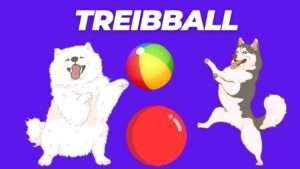From the enthusiastic wagging of a dog’s tail to the eager glint in their eyes, there’s something undeniably captivating about a game of fetch. But what lies beneath this seemingly simple activity that has dogs of all breeds and sizes hooked? Why do they delight in chasing after thrown objects with such fervor? Join us as we delve into the intriguing world of fetch, exploring the science behind this beloved pastime and uncovering why dogs just can’t seem to get enough of it.
Contents Overview
The Evolutionary Roots of Fetch
To understand the deep-seated fascination that dogs have with fetch, we must journey back through the annals of evolutionary history to explore the origins of this beloved pastime. The story begins with the domestic dog’s ancestor, the wolf, whose survival depended on hunting and scavenging for food in the wild.
1. Hunting and Gathering Instincts:
Wolves, as apex predators, relied on their keen senses and coordinated pack behavior to pursue and capture prey. This instinctual drive for hunting and gathering played a pivotal role in shaping their behavior and social structure. Through generations of natural selection, wolves developed sophisticated strategies for chasing down prey, including pursuit and retrieval.
2. Cooperative Hunting Dynamics:
Wolves are highly social animals that hunt in packs, relying on cooperation and coordination to secure their next meal. This cooperative hunting dynamic involves intricate communication, teamwork, and division of labor among pack members. Each wolf has a role to play in the hunt, whether it’s chasing down prey, herding it towards the pack, or guarding the kill.
3. Development of Retrieval Behavior:
In the context of hunting, retrieval behavior serves a crucial function in bringing back prey to the pack for consumption. Wolves that exhibited a propensity for retrieving objects, such as wounded prey or scavenged food, would have gained a survival advantage, as it ensured a stable food supply for the pack. Over time, this behavior became ingrained in the genetic makeup of wolves, laying the groundwork for the emergence of fetch-like behaviors.
4. Domestication and Canine Play:
As humans transitioned from hunter-gatherer societies to agrarian civilizations, wolves began to coexist with humans, drawn to the abundant food sources found in human settlements. Through a process of natural selection and selective breeding, certain wolves displayed traits that made them more compatible with human companionship, eventually leading to the domestication of dogs.
5. Transition to Canine Companionship:
With the evolution of the domestic dog, the dynamics of play shifted from survival-driven behaviors to forms of social interaction and bonding with humans. Fetch, rooted in the ancestral instincts of pursuit and retrieval, evolved into a recreational activity that served both practical and emotional purposes for dogs and their human counterparts.
6. Continuation of Instinctual Behaviors:
Despite millennia of domestication, dogs retain many of their ancestral instincts, including the inclination towards play and the thrill of pursuit. Fetch provides an outlet for these innate behaviors, allowing dogs to engage in activities that stimulate their senses, fulfill their instincts, and strengthen their bonds with humans.
In summary, the evolutionary roots of fetch can be traced back to the hunting and gathering instincts of the domestic dog’s ancestor, the wolf. Through millennia of natural selection and domestication, fetch has evolved from a survival-driven behavior to a cherished pastime that embodies the enduring bond between humans and their canine companions.
Understanding Canine Psychology
To comprehend the complexities of canine behavior and unravel the mysteries of why dogs are so captivated by activities like fetch, it’s essential to delve into the fascinating realm of canine psychology. Dogs, as social animals with rich emotional lives, exhibit a wide range of behaviors influenced by their instincts, experiences, and interactions with their environment.
1. Social Nature of Dogs:
At the core of canine psychology lies their innate social nature. Dogs are pack animals, descended from wolves, and as such, they thrive in environments where they can form close bonds and establish social hierarchies. Within a pack or family unit, dogs exhibit behaviors such as cooperation, communication, and mutual reliance.
2. Importance of Play:
Play serves a vital role in the psychological development of dogs, providing opportunities for socialization, learning, and stress relief. Through play, dogs learn important skills such as communication, problem-solving, and self-regulation. Playful interactions with other dogs or humans also help strengthen social bonds and promote emotional well-being.
3. Need for Mental Stimulation:
Dogs are intelligent creatures with a keen sense of curiosity and a need for mental stimulation. Lack of mental enrichment can lead to boredom, frustration, and undesirable behaviors such as excessive barking or destructive chewing. Engaging activities like fetch stimulate a dog’s mind, keeping them mentally sharp and fulfilled.
4. Role of Instincts:
Despite centuries of domestication, dogs retain many of their ancestral instincts, which influence their behavior and preferences. Instincts such as hunting, herding, and territoriality shape how dogs interact with their environment and respond to stimuli. Fetch taps into these instincts, allowing dogs to engage in behaviors reminiscent of their wild ancestors.
5. Emotional Sensitivity:
Dogs are highly attuned to human emotions and possess a remarkable ability to interpret subtle cues from their human counterparts. They can sense when their owners are happy, sad, or anxious and often respond with empathy and affection. Playing fetch with a beloved human companion not only provides physical exercise but also fosters emotional connection and strengthens the bond between dog and owner.
6. Individual Differences:
Just as humans have unique personalities and preferences, so too do dogs. Factors such as breed, age, past experiences, and temperament can influence a dog’s behavior and attitude towards activities like fetch. Some dogs may have a natural inclination for play and enjoy fetch from the outset, while others may require patience, encouragement, and training to fully embrace the game.
In conclusion, understanding canine psychology is essential for nurturing a fulfilling and harmonious relationship with our canine companions. By recognizing the social, cognitive, and emotional needs of dogs and providing them with opportunities for play, mental stimulation, and social interaction, we can enrich their lives and strengthen the bonds that unite us as human and canine companions.
The Thrill of the Chase: Why Dogs Love Retrieving Objects
Have you ever marveled at the sheer joy and enthusiasm with which dogs pursue thrown objects during a game of fetch? The sight of a dog bounding across the grass, tail wagging furiously, eyes fixed intently on the airborne toy—it’s a testament to the profound pleasure they derive from the simple act of chasing and retrieving objects. But what exactly fuels this seemingly innate passion for the chase? Let’s explore the fascinating reasons why dogs are so enamored with this timeless game.
1. Sensory Stimulation:
Imagine the world from a dog’s perspective—a symphony of sights, sounds, and scents waiting to be explored. When a dog sets off in pursuit of a thrown object, their senses are instantly heightened, captivated by the sight of the flying toy, the sound of it whizzing through the air, and the scent lingering on its surface. This sensory overload triggers a surge of excitement and arousal, igniting their instinctual drive to chase and capture their quarry.
2. Fulfillment of Instincts:
At their core, dogs are descendants of hunters and scavengers, hardwired by millennia of evolution to pursue and capture prey. Fetch taps into these primal instincts, allowing dogs to engage in behaviors reminiscent of their wild ancestors. The act of chasing and retrieving objects satisfies a fundamental urge to hunt and capture, triggering a sense of fulfillment and satisfaction deep within their canine psyche.
3. Bonding with Humans:
Dogs are social creatures with an innate desire for companionship and connection. When they engage in a game of fetch with their human companions, it’s not just about chasing after a thrown object—it’s a shared experience, a moment of joyful camaraderie. Fetch provides an opportunity for dogs to bond with their owners, strengthening the emotional connection between human and canine through collaborative play and shared excitement.
4. Physical Exercise:
In addition to the mental stimulation and emotional fulfillment it provides, fetch is also an excellent form of physical exercise for dogs. The running, jumping, and retrieving involved in the game offer a full-body workout, helping dogs burn off excess energy, maintain a healthy weight, and strengthen their muscles and joints. Regular exercise is essential for a dog’s overall health and well-being, and fetch offers a fun and effective way to keep them active and engaged.
5. Positive Reinforcement:
Another key factor that contributes to dogs’ love for fetching objects is positive reinforcement. When a dog successfully retrieves an object and brings it back to their owner, they are often rewarded with praise, treats, or affection—a powerful incentive that reinforces the behavior and encourages them to repeat it. This cycle of action and reward strengthens the association between fetching and positive outcomes, further fueling their enthusiasm for the game.
In essence, the thrill of the chase is deeply ingrained in the canine psyche, fueled by a combination of sensory stimulation, instinctual drive, social bonding, physical exercise, and positive reinforcement. So the next time you toss a ball or a frisbee for your furry friend, take a moment to appreciate the sheer delight they experience in the simple act of chasing and retrieving objects—a joyous expression of their innate nature as playful, energetic, and deeply connected creatures.
The Role of Positive Reinforcement
Positive reinforcement is a fundamental principle in dog training and behavior modification, wielding a profound influence on a dog’s attitudes, behaviors, and responses. In the context of fetch, positive reinforcement plays a pivotal role in shaping and enhancing a dog’s enthusiasm for the game. Let’s delve into the intricacies of positive reinforcement and explore how it transforms fetch into a rewarding and enjoyable experience for both dogs and their human companions.
1. Understanding Positive Reinforcement:
At its core, positive reinforcement involves the presentation of a desirable stimulus or reward following a desired behavior, with the aim of increasing the likelihood of that behavior recurring in the future. In the context of fetch, positive reinforcement typically takes the form of praise, treats, toys, or affection, provided to the dog as a reward for retrieving and returning the thrown object.
2. Reinforcing Desired Behaviors:
Positive reinforcement serves as a powerful tool for reinforcing desired behaviors in dogs. When a dog successfully retrieves an object and brings it back to their owner, they are often met with enthusiastic praise, a tasty treat, or a playful game of tug-of-war with the retrieved item. This immediate reward reinforces the behavior of fetching and returning, encouraging the dog to repeat the action in anticipation of further rewards.
3. Building Associations and Motivation:
Through consistent use of positive reinforcement, dogs learn to associate the act of fetching with pleasurable outcomes. Each successful retrieval becomes a positive experience, strengthening the dog’s motivation to engage in the behavior again. Over time, this association forms a powerful bond between the action of fetching and the anticipation of rewards, fueling the dog’s enthusiasm for the game.
4. Strengthening the Human-Canine Bond:
Positive reinforcement not only shapes a dog’s behavior but also strengthens the bond between dog and owner. When a dog receives praise, treats, or affection as a reward for fetching, it reinforces their connection with their human companion and fosters a sense of trust, cooperation, and mutual understanding. Fetch becomes not just a game, but a shared experience that deepens the emotional bond between human and canine.
5. Consistency and Timing:
Effective use of positive reinforcement relies on consistency and timing. It’s essential to deliver rewards promptly and consistently following the desired behavior to ensure that the dog makes the connection between the action and the reward. By providing immediate reinforcement, you reinforce the desired behavior and increase the likelihood of its repetition in future fetch sessions.
6. Tailoring Rewards to Individual Dogs:
Every dog is unique, with their own preferences, motivations, and sensitivities. Tailoring rewards to suit the individual needs and preferences of your dog can enhance the effectiveness of positive reinforcement in fetch training. Some dogs may be highly food-motivated and respond best to treats, while others may prefer toys or verbal praise as rewards. Experimenting with different types of rewards can help you discover what motivates your dog most effectively.
In summary, positive reinforcement serves as a cornerstone of fetch training, transforming the game into a rewarding and enjoyable experience for dogs and their human companions alike. By using praise, treats, toys, and affection to reinforce desired behaviors, you can strengthen the bond between you and your furry friend while fostering a love for fetch that will endure for years to come.
Factors Influencing Fetch Behavior
While fetch may appear to be a straightforward game of chasing and retrieving objects, the enthusiasm with which dogs engage in this activity can be influenced by a myriad of factors. From breed characteristics to past experiences, various elements shape a dog’s attitude towards fetch and their willingness to participate fully in the game. Let’s explore the key factors that can influence fetch behavior and delve into the complexities of canine play.
- Breed Traits:
Different dog breeds have been selectively bred for specific purposes, resulting in a wide range of temperaments, instincts, and physical attributes. These breed traits can influence how dogs approach and engage in activities like fetch. For example:
- Retrievers, such as Labrador Retrievers and Golden Retrievers, are bred for retrieving game during hunting, making them naturally inclined towards fetching objects.
- Herding breeds, such as Border Collies and Australian Shepherds, may exhibit a strong instinct to chase and retrieve objects due to their herding heritage.
- Sight hounds, like Greyhounds and Whippets, may enjoy chasing after thrown objects but may be less inclined to bring them back due to their independent nature.
- Age and Developmental Stage:
A dog’s age and developmental stage can also influence their enthusiasm for fetch. Puppies, with their boundless energy and curiosity, may eagerly chase after thrown objects but may lack the focus or impulse control to consistently retrieve them. As dogs mature and their training progresses, their fetch behavior may evolve and become more reliable.
- Past Experiences and Training:
A dog’s past experiences with fetch and their training history can significantly impact their attitude towards the game. Dogs that have had positive experiences and effective training with fetch are more likely to view it as an enjoyable activity and eagerly participate. Conversely, dogs that have had negative experiences or lack proper training may be hesitant or reluctant to engage in fetch.
- Personality and Temperament:
Just like humans, dogs have unique personalities and temperaments that influence their behavior. Some dogs may have a natural predisposition towards playfulness and enthusiasm, making them eager participants in fetch. Others may be more reserved or independent, requiring more encouragement or patience to fully engage in the game.
- Health and Physical Condition:
A dog’s health and physical condition can also impact their ability and willingness to participate in fetch. Dogs that are in good health and have high energy levels may be more inclined to engage in vigorous play, including fetch. Conversely, dogs with health issues or physical limitations may have reduced stamina or mobility, affecting their ability to play fetch comfortably.
- Environmental Factors:
The environment in which fetch takes place can influence a dog’s behavior and enjoyment of the game. Factors such as weather conditions, terrain, distractions, and the presence of other animals or people can all impact a dog’s focus and engagement during fetch sessions.
In summary, fetch behavior is influenced by a combination of breed traits, age, past experiences, personality, health, and environmental factors. By understanding and considering these various elements, dog owners can tailor fetch activities to suit their dog’s individual needs and preferences, fostering a positive and enjoyable experience for both canine and human participants.
Bottom Line
In the intricate tapestry of canine behavior, fetch emerges as a vibrant thread, weaving together instinct, play, and companionship. As we unravel the science behind this beloved pastime, it becomes evident that fetch is more than just a game—it’s a manifestation of the deep bond between humans and their canine companions. So the next time you engage in a spirited game of fetch with your four-legged friend, take a moment to appreciate the rich tapestry of instincts, emotions, and experiences that intertwine to create moments of pure joy and connection.




























+ There are no comments
Add yours